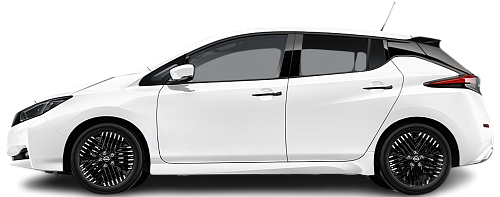Global EV Comparison: Kia Soul EV Standard Range vs Nissan Leaf 40 kWh
Struggling to Decide? Let AI Help!
Your AI Summary Is Ready!
General Info
The Kia Soul EV Standard Range (2020-…) is currently produced, it has a starting price of €38418. The Nissan Leaf 40 kWh (2022-2025) has been discontinued. You can find it for as low as €15890 on the used car market.
The Kia Soul EV Standard Range (2020-…) is a SUV, whereas the Nissan Leaf 40 kWh (2022-2025) is a Hatchback.
| Property | Kia Soul EV Standard Range | Nissan Leaf 40 kWh |
|---|---|---|
| Years of Production | 2020-… | 2022-2025 |
| Current Status | Produced | Discontinued |
| Country of Manufacture | South Korea | Japan, UK, USA |
| Body Style | SUV | Hatchback |
| Market Availability | EU | EU, USA |
| Price Europe (New) | €38418 | - Price Europe (New) |
| Price Europe (Used) | €15999 | €15890 |
| GCC Score | 5.1 | 4.8 |
Range and Efficiency
Even though the Kia Soul EV Standard Range (2020-…) has a larger battery, the Nissan Leaf 40 kWh (2022-2025) higher energy efficiency results in a longer real-world driving range.
| Property | Kia Soul EV Standard Range | Nissan Leaf 40 kWh |
|---|---|---|
| Range (EPA) | - Range (EPA) | 240 km |
| Range (WLTP) | 276 km | 285 km |
| Range (GCC) | 235 km | 238 km |
| Battery Capacity (Nominal) | 42 kWh | 40 kWh |
| Battery Capacity (Usable) | 39.2 kWh | 39 kWh |
| Efficiency per 100 km | 16.7 kWh/100 km | 16.4 kWh/100 km |
| Efficiency per kWh | 5.99 km/kWh | 6.1 km/kWh |
| Range and Efficiency Score | 5.4 | 5.5 |
Charging
Both vehicles utilize a standard 400-volt architecture.
The Nissan Leaf 40 kWh (2022-2025) offers faster charging speeds at DC stations, reaching up to 50 kW, while the Kia Soul EV Standard Range (2020-…) maxes out at 44 kW.
The Kia Soul EV Standard Range (2020-…) features a more powerful on-board charger, supporting a maximum AC charging power of 7.2 kW, whereas the Nissan Leaf 40 kWh (2022-2025) is limited to 3.6 kW.
| Property | Kia Soul EV Standard Range | Nissan Leaf 40 kWh |
|---|---|---|
| Max Charging Power (AC) | 7.2 kW | 3.6 kW |
| Max Charging Power (DC) | 44 kW | 50 kW |
| Architecture | 400 V | 400 V |
| Charge Port | CCS Type 2 | CHAdeMO |
| Charging Score | 4 | 3.3 |
Performance
Both vehicles are front-wheel drive.
The Nissan Leaf 40 kWh (2022-2025) boasts greater motor power and accelerates faster from 0 to 100 km/h.
| Property | Kia Soul EV Standard Range | Nissan Leaf 40 kWh |
|---|---|---|
| Drive Type | FWD | FWD |
| Motor Type | PMSM | PMSM |
| Motor Power (kW) | 100 kW | 110 kW |
| Motor Power (hp) | 134 hp | 148 hp |
| Motor Torque | 395 Nm | 320 Nm |
| 0-100 km/h | 9.9 s | 7.9 s |
| Top Speed | 157 km/h | 144 km/h |
| Performance Score | 3.1 | 3.1 |
Dimensions
The Nissan Leaf 40 kWh (2022-2025) has a longer body, while the Kia Soul EV Standard Range (2020-…) stands taller, offering a more elevated ride. Their widths are almost identical, so both offer a similar amount of shoulder room.
The Nissan Leaf 40 kWh (2022-2025) boasts a more extended wheelbase.
| Property | Kia Soul EV Standard Range | Nissan Leaf 40 kWh |
|---|---|---|
| Length | 4195 mm | 4490 mm |
| Width (with Mirrors) | - Width (with Mirrors) | 2030 mm |
| Width (w/o Mirrors) | 1800 mm | 1788 mm |
| Height | 1605 mm | 1530 mm |
| Wheelbase | 2600 mm | 2700 mm |
Cargo and Towing
The Nissan Leaf 40 kWh (2022-2025) features a larger trunk, but the Kia Soul EV Standard Range (2020-…) offers greater maximum cargo capacity when the rear seats are folded.
Neither car is equipped with a frunk (front trunk).
Neither vehicle is officially rated for towing in in the EU.
| Property | Kia Soul EV Standard Range | Nissan Leaf 40 kWh |
|---|---|---|
| Number of Seats | 5 | 5 |
| Curb Weight | 1610 kg | 1580 kg |
| Cargo Volume (Trunk) | 315 l | 435 l |
| Cargo Volume (Max) | 1339 l | 1176 l |
| Cargo Volume (Frunk) | - Cargo Volume (Frunk) | - Cargo Volume (Frunk) |
| Towing Capacity | - Towing Capacity | - Towing Capacity |
| Cargo and Towing Score | 5.5 | 4.5 |




